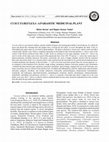Papers by Dr.Rajeev Kumar Yadav

Nisha Verma1 and Rajeev Kumar Yadav2, 2018
Cuscuta reflexa is an extensive leafless, parasitic climber belong to the morning glory family Co... more Cuscuta reflexa is an extensive leafless, parasitic climber belong to the morning glory family Convolvulaceae. It is yellowish
green and thread like twinning herb and tangled mass covering the host plant. It occurs throughout the India. It has no
chlorophyll and cannot make its own food by photosynthesis. The plant is attached to various trees, shrubs, herbs and affect
commercially valuable crops. Plant is completely dependent on host plant for their food and nutrition. C. reflexa varies in the
colours of the flowers produced from white to pink. Seeds are produced in the large quantities. Seeds of C. reflexa can
survive in the soil for many years in the search of the appropriate host. It has 100-170 species. C. reflexa has various type of
phytoconstituents including chemicals, flavonoids, carotenoids, the esters of higher aliphatic alcohol with the saturated
fatty acids and carbon atoms. It is a parasite plant it sucks nutrient from the host plant for its growth and development hence
its phytoconstituent also depends on the host plant. C. reflexa has been used from ancient times for various purposes viz.
as a purgative in the treatment of liver disorder, cough, itching, constipation, flutance, body pain, jaundice, gout, rheumatism
, urination disorders muscles pain, impotence, premature ejaculation, sperm leakage, ringing in the ear, lower back pain, sore
knees, leucorrhea, dry eyes, blurred vision and tired eyes. It exhibits anti inflammatory, antiviral, antibacterial, anticonvulsant,
antiseptic, analgesic, anesthetic, anti oxidant, antipyretic, bodycardia, antisteroidogenic, antiplasmodic, hemodynamic,
nematicide, anti androgenic, hypocholestrolemic, antiandrogenic, hemolytic, diuretic, dermatigenic, immunostimulant,
antiarthritic, antiasthma and anticancer activities. C. reflexa is a parasitic weed plant and causes a huge loss to the crop
plants every year, still C. reflexa is called as miracle medicinal plant because many chemical compounds have been isolated
from this plant having medicinal properties.
Journal of emerging technologies and innovative research, Sep 1, 2018
The world of floral diversity is amazing. India has rich and varied flora just like its culture. ... more The world of floral diversity is amazing. India has rich and varied flora just like its culture. Plants are so amazing and beneficial for human being in every aspect. Without plants life is not possible on earth. Plant and flowers are also used for decoration of home as ornamental, some plants are poisonous in nature.
Journal of emerging technologies and innovative research, May 1, 2020

Ocimum sanctum, A medicinal herb, belongs to the family Lamiaceae. It is erect, branched and frag... more Ocimum sanctum, A medicinal herb, belongs to the family Lamiaceae. It is erect, branched and fragrant, having height of about 30-60 cm. Different part of the plant are used to cure so many diseases, such as headache, leucoderma, asthma, bronchitis, fever, vomiting, hiccups, ophthalmic, genitourinary disorders, ring worms and skin diseases, coughs, diarrhea, constipation, wart, worm, influenza, common cold, colic pain, hepatic diseases, arthritis, digestive disorders and kidney dysfunctions. It has variety of pharmacological activities such as Anti microbial activity, Antidiabetic activity, Antistress activity, Antifirtility activity, Hepatoprotective activity, Immunomodulatory activity, Psychopharmacological activity, Antioxidant activity, Antipyretic activity, Anticarcinogenic activity, Antiasthmatic activity Antiulcerogenic activity, Radioprotective activity, Anticataract activity, Wound healing activity , Antiinflammatory activity, Antiarthritic activity, Anticoagulant activity ,...











Uploads
Papers by Dr.Rajeev Kumar Yadav
green and thread like twinning herb and tangled mass covering the host plant. It occurs throughout the India. It has no
chlorophyll and cannot make its own food by photosynthesis. The plant is attached to various trees, shrubs, herbs and affect
commercially valuable crops. Plant is completely dependent on host plant for their food and nutrition. C. reflexa varies in the
colours of the flowers produced from white to pink. Seeds are produced in the large quantities. Seeds of C. reflexa can
survive in the soil for many years in the search of the appropriate host. It has 100-170 species. C. reflexa has various type of
phytoconstituents including chemicals, flavonoids, carotenoids, the esters of higher aliphatic alcohol with the saturated
fatty acids and carbon atoms. It is a parasite plant it sucks nutrient from the host plant for its growth and development hence
its phytoconstituent also depends on the host plant. C. reflexa has been used from ancient times for various purposes viz.
as a purgative in the treatment of liver disorder, cough, itching, constipation, flutance, body pain, jaundice, gout, rheumatism
, urination disorders muscles pain, impotence, premature ejaculation, sperm leakage, ringing in the ear, lower back pain, sore
knees, leucorrhea, dry eyes, blurred vision and tired eyes. It exhibits anti inflammatory, antiviral, antibacterial, anticonvulsant,
antiseptic, analgesic, anesthetic, anti oxidant, antipyretic, bodycardia, antisteroidogenic, antiplasmodic, hemodynamic,
nematicide, anti androgenic, hypocholestrolemic, antiandrogenic, hemolytic, diuretic, dermatigenic, immunostimulant,
antiarthritic, antiasthma and anticancer activities. C. reflexa is a parasitic weed plant and causes a huge loss to the crop
plants every year, still C. reflexa is called as miracle medicinal plant because many chemical compounds have been isolated
from this plant having medicinal properties.
green and thread like twinning herb and tangled mass covering the host plant. It occurs throughout the India. It has no
chlorophyll and cannot make its own food by photosynthesis. The plant is attached to various trees, shrubs, herbs and affect
commercially valuable crops. Plant is completely dependent on host plant for their food and nutrition. C. reflexa varies in the
colours of the flowers produced from white to pink. Seeds are produced in the large quantities. Seeds of C. reflexa can
survive in the soil for many years in the search of the appropriate host. It has 100-170 species. C. reflexa has various type of
phytoconstituents including chemicals, flavonoids, carotenoids, the esters of higher aliphatic alcohol with the saturated
fatty acids and carbon atoms. It is a parasite plant it sucks nutrient from the host plant for its growth and development hence
its phytoconstituent also depends on the host plant. C. reflexa has been used from ancient times for various purposes viz.
as a purgative in the treatment of liver disorder, cough, itching, constipation, flutance, body pain, jaundice, gout, rheumatism
, urination disorders muscles pain, impotence, premature ejaculation, sperm leakage, ringing in the ear, lower back pain, sore
knees, leucorrhea, dry eyes, blurred vision and tired eyes. It exhibits anti inflammatory, antiviral, antibacterial, anticonvulsant,
antiseptic, analgesic, anesthetic, anti oxidant, antipyretic, bodycardia, antisteroidogenic, antiplasmodic, hemodynamic,
nematicide, anti androgenic, hypocholestrolemic, antiandrogenic, hemolytic, diuretic, dermatigenic, immunostimulant,
antiarthritic, antiasthma and anticancer activities. C. reflexa is a parasitic weed plant and causes a huge loss to the crop
plants every year, still C. reflexa is called as miracle medicinal plant because many chemical compounds have been isolated
from this plant having medicinal properties.